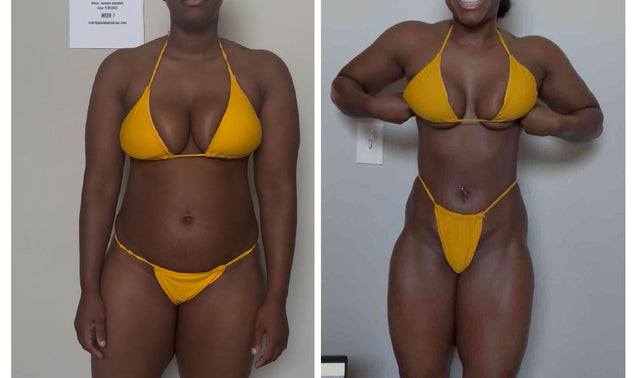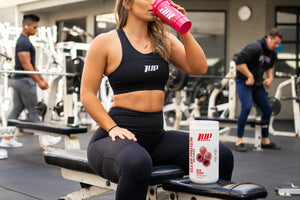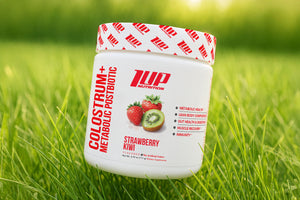Joint pain affects ~25% of adults in the USA each year.[1]
Recent estimates also indicate that joint pain is higher among women (29.2%) than men (22.7%).[1]
One of the most common sites of joint pain, especially for those who lead active lifestyles, is the knee.
Today, we discuss some of the contributing factors that lead to knee pain and what you can do to strengthen the tissues surrounding this important joint to reduce pain.
An Overview on the Knee Joint
The knee is a hinge joint (similar to the elbow) that connects the upper and lower leg bones.
Its function is to allow for flexion and extension of the lower leg relative to the thigh.
The range of motion of the knee is limited by the anatomy of the bones and ligaments, but typically allows for ~120 degrees of flexion. Interestingly, the knee joint also allows for a small degree of medial and lateral rotation when it is moderately flexed -- this isn’t the case with all hinge joints in the body.
Several strong ligaments surround the joint capsule of the knee to reinforce its structure and hold its bones in the proper alignment.
They are:
- ACL -- anterior cruciate ligament
- PCL -- posterior cruciate ligament
- MCL -- medial collateral ligament
- LCL -- lateral collateral ligament
- patellar ligament
- oblique popliteal ligament
- arcuate popliteal ligament
You’ve likely heard of many of these ligaments, especially when hearing about sports injuries.
In addition to numerous ligaments, there are also several other important structures surrounding the knee that help cushion and protect the joint from friction and external forces.
For instance, bursae are small pockets of synovial fluid that surround the knee to reduce the friction from the movement of tendons across the surface of the knee joint.
Contributing Factors to Knee Pain
There are several factors that can lead to knee pain, but for the average fitness enthusiast, the primary cause of knee pain is due to an imbalance in the muscles surrounding your knee.
For instance, weak hamstrings (relative to the quads) can lead to increased strain on the anterior cruciate ligament (ACL).
Additionally, tight hamstrings relative to weakness in the quads is also known to lead to pain in the front of the knee.
Imbalances between the quads and hamstrings aren’t the only things that lead to knee pain in athletes. Muscle imbalances in the hips (abductors and external rotators) can also cause patellofemoral tracking problems and have deleterious effects on the knee.
Moving beyond muscle imbalances another common cause of knee pain is arthritis -- swelling and tenderness in the joint caused by inflammation.
If you are experiencing knee pain or feel a weakness in or around the joint, you need to consult a medical professional as they will confirm whether or not there is structural damage to the joint that needs to be addressed.
If your knee pain is a result of muscle imbalance, here are some tips to help strengthen the structures surrounding your knee.
Tips for Strengthening Your Knees
First off, it’s important to know that you can’t “strengthen” your knee -- the knee is a joint composed of bones, ligaments, and connective tissue. What you can do is strengthen the tissues surrounding the joint to ensure proper knee function.
With that said, let’s get started.
#1 Physical Activity
Regular physical activity is one of the best things you can do for your joints, period. Performing joint-friendly activities has been shown to help reduce pain, improve mood, and increase range of motion in people with arthritis reduce pain and increase range of motion.
#2 Perform a Thorough Warm Up
It can be tempting to walk in the gym and immediately load up a bunch of plates and start banging out reps.
But, if you’re someone dealing with joint pain, you’d be better served to take things slowly and perform a thorough warm up.
Warm ups increase circulation, prime the CNS, and lubricate the joints with synovial fluid. They also serve as a warning sign and let you know if a particular muscle or joint has weakness, thereby allowing you to decide the best course of action for your workout.
#3 Knee Extension Exercises
As we mentioned above, one of the primary functions of the knee is extension. It stands to reason that to strengthen the tissues (namely the muscles surrounding the knee) you knee to perform exercises that involve knee extension.
The most obvious choice here is the leg extension machine, but that’s not the only option you have.
You can also perform terminal knee extensions (TKEs) which strengthen the vastus medialis oblique (VMO) -- a muscle of the quadriceps that play a HUGE role in knee stability.
These exercises can be performed at the beginning of your workout to establish the mind-muscle connection and prime the quads for heavier squats, lunges, and leg presses. They can also be used for higher rep “burnout” moves at the end of your workout.
#4 Knee Flexion Exercises
Since knee pain can occur as a result of imbalances between the muscles on the front side of the thigh (quadriceps) and the backside of the thigh (hamstrings), it’s important to perform exercises that also strengthen the muscles involved in knee flexion.
Furthermore, most athletes tend to be quad-dominant, which makes it all the more important to train the hamstrings and prevent knee pain.
The top pick for this movement pattern is the leg curl.
It can be performed both seated or standing, bilaterally (both legs) or unilaterally (single leg). It can also be performed using a suspension trainer, or our personal favorite -- the sliding leg curl performed on the floor. The added benefit of the sliding floor leg curl is that it trains both functions of the hamstrings -- knee flexion and hip extension -- thereby offering a double whammy to the backsides of your legs.
#5 Take it Slow
This tip goes part and parcel with tip #2 (perform a thorough warm up). It can be incredibly tempting to put the proverbial “cart before the horse” and jump straight into your heavy work.
But, it’s vitally important that you slowly acclimate your muscles, joints, ligaments, and connective tissue to intense, strenuous exercise. It both primes you for optimal performance and reduces the likelihood of injury/pain.
Make sure you are using a slow, controlled lifting tempo on every exercise, such that the muscles are receiving the tension, not the joints and support structures.
#6 Choose Low Impact Exercises
When dealing with knee pain, it’s important to choose low-impact forms of activity -- walking, swimming, etc. These forms of physical activity are easy on the joints, but help increase circulation, joint mobility, and range of motion -- thereby supporting recovery.
#7 Consume the Right Nutrients
Arthritis is an inflammatory disorder and one of the common causes of joint pain.
To help reduce inflammation, it’s important to consume nutrients that combat oxidative stress and free radicals.
Key nutrients that fight inflammation are polyphenols, flavonoids, and antioxidants found in fruits, vegetables, and greens supplements.
Omega-3 fatty acids and fish oils also are known to help reduce inflammation and support joint health.[4]
Lastly, don’t forget about collagen peptides.
Collagen is the primary structural protein in the body and supplementation with collagen has been shown to reduce joint pain in athletes and possibly reduce the risk of joint deterioration.[5]
References
- Joint pain and arthritis. (2020, May 22). Centers for Disease Control and Prevention. https://www.cdc.gov/arthritis/pain/index.htm
- Hunter DJ, Eckstein F. Exercise and osteoarthritis. J Anat. 2009;214(2):197-207. doi:10.1111/j.1469-7580.2008.01013.x
- Urquhart DM, Wluka AE, Teichtahl AJ, Cicuttini FM. The effect of physical activity on the knee joint: is it good or bad?. Br J Sports Med. 2007;41(9):546-547. doi:10.1136/bjsm.2007.037416
- Rajaei E, Mowla K, Ghorbani A, Bahadoram S, Bahadoram M, Dargahi-Malamir M. The Effect of Omega-3 Fatty Acids in Patients With Active Rheumatoid Arthritis Receiving DMARDs Therapy: Double-Blind Randomized Controlled Trial. Glob J Health Sci. 2015;8(7):18-25. Published 2015 Nov 3. doi:10.5539/gjhs.v8n7p18
- Clark KL, Sebastianelli W, Flechsenhar KR, et al. 24-Week study on the use of collagen hydrolysate as a dietary supplement in athletes with activity-related joint pain. Curr Med Res Opin. 2008;24(5):1485-1496. doi:10.1185/030079908x291967






